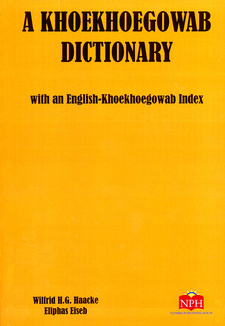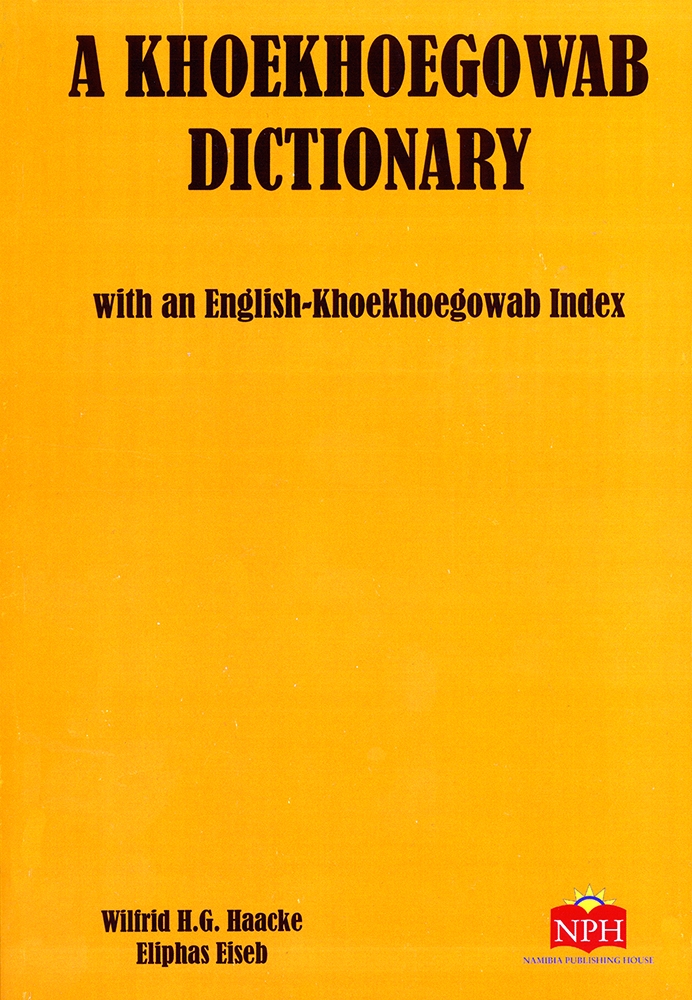A Khoekhoegowab Dictionary, by Wilfred H.G. Haacke und Eliphas Eiseb

A Khoekhoegowab Dictionary, by Wilfred H.G. Haacke und Eliphas Eiseb. Namibia Publishershing House (Pty) Ltd. Windhoek, Namibia 2018 (Reprint of 2002 edition). ISBN 9789991604015 / ISBN 978-99916-0-401-5
How to use the Khoekhoegowab Dictionary by Wilfred H.G. Haacke und Eliphas Eiseb. A generous subsidy by the Upgrading African Language Project (African), which is implemented by the National Institute for Educational Development (NIED) and supported by the Gesellschaft fur Technische Zusammenarbeit (GTZ) allows this book to be made available to the public.
The primary aim of this dictionary is to document as widely as possible the lexicon of Khoekhoegowab, the language that for some time was referred to as Nama/Damara and is considered to be an endangered language. While on the one hand it is hoped to stem the farther recession of this last surviving language of the Central Khoesaan family, it is also intended to provide access for its speakers to English and thereby the international community. The dictionary also includes words that are archaic or may become so if not preserved. Such words may also provide valuable clues for comparative and historical studies in Central Khoesaan. Practical constraints did not allow for the compilation of a symmetrical bilingual dictionary, that is, for the compilation also of an English-Khoekhoegowab dictionary. For this reason most of the English renderings of the Khoekhoegowab-English dictionary have been accommodated in an Index, so as to provide access to the Khoekhoegowab entries with their derivations in the actual dictionary. The Index is not purported to be a glossary, as the compilers did not attempt to coin Khoekhoegowab words for English concepts, where such words are not already in existence. Hence, omissions of fairly common English words in the English-Khoekhoegowab section are inevitable, as that part is an automatic inversion of the original Khoekhoegowab-English inventory. Space constraints in the electronic database did not always permit the inclusion of all of these English renderings. For this reason an English concept may occasionally appear in a derived word category, rather than a primary one (noun or verb). The user is thus advised to access the relevant Khoekhoegowab entry in the dictionary, so as to peruse all associated derivations included in an article. English phrases in the Index have normally been entered under the most important word(s) of that phrase, not necessarily under its first word. Thus, for instance, sM.bte is listed under brother -your elder. For reasons of space, adverbs that are derived regularly in both English and Khoekhoegowab (with -ly and -se respectively) have not been included in the Index.
The user should consider that the Index uses only the spelling as adapted for tonological marking, not the standardised orthography. The dictionary aims to cater for both purposes that a dictionary with Khoekhoegowab as source language can have: It provides for the speakers of Khoekhoegowab that wish to express themselves in English, and it provides for non-speakers of Khoekhoegowab that wish to understand a Khoekhoegowab word. For the former user the dictionary thus provides a wider selection of possible English renderings and synonyms; for the latter user examples of Khoekhoegowab usage (in italics), cross-references to similar or contrastive words (in capitals) and, occasionally, brief cultural notes (in square brackets) are added. This dictionary authoritatively employs the standardised orthography of Khoekhoegowab, with - however - certain systematic adaptations for the marking of tone. These adaptations are required for the accommodation of tone marks in print, and the sorting of entries follows the adapted version. [...]
This is an excerpt from A Khoekhoegowab Dictionary, by Wilfred H.G. Haacke und Eliphas Eiseb.
Title: A Khoekhoegowab Dictionary
Editors: Wilfred H.G. Haacke; Eliphas Eiseb
Publisher: Namibia Publishershing House (Pty) Ltd
Windhoek, Namibia 2018 (Reprint of 2002 edition)
ISBN 9789991604015 / ISBN 978-99916-0-401-5
Softcover, 17 x 26 cm, 740 pages
Haacke, Wilfred H.G. und Eiseb, Eliphas im Namibiana-Buchangebot
A Khoekhoegowab Dictionary
A Khoekhoegowab Dictionary for the language of mainly the Damara, Haillom and Nama population in Namibia.

